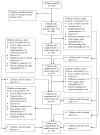Incident Vertebral Fractures in Children With Leukemia During the Four Years Following Diagnosis
- PMID: 26171800
- PMCID: PMC4909472
- DOI: 10.1210/JC.2015-2176
Incident Vertebral Fractures in Children With Leukemia During the Four Years Following Diagnosis
Abstract
Objectives: The purpose of this article was to determine the incidence and predictors of vertebral fractures (VF) during the 4 years after diagnosis in pediatric acute lymphoblastic leukemia (ALL).
Patients and methods: Children were enrolled within 30 days of chemotherapy initiation, with incident VF assessed annually on lateral spine radiographs according to the Genant method. Extended Cox models were used to assess the association between incident VF and clinical predictors.
Results: A total of 186 children with ALL completed the baseline evaluation (median age, 5.3 years; interquartile range, 3.4-9.7 years; 58% boys). The VF incidence rate was 8.7 per 100 person-years, with a 4-year cumulative incidence of 26.4%. The highest annual incidence occurred at 12 months (16.1%; 95% confidence interval [CI], 11.2-22.7), falling to 2.9% at 4 years (95% CI, 1.1-7.3). Half of the children with incident VF had a moderate or severe VF, and 39% of those with incident VF were asymptomatic. Every 10 mg/m(2) increase in average daily glucocorticoid dose (prednisone equivalents) was associated with a 5.9-fold increased VF risk (95% CI, 3.0-11.8; P < .01). Other predictors of increased VF risk included VF at diagnosis, younger age, and lower spine bone mineral density Z-scores at baseline and each annual assessment.
Conclusions: One quarter of children with ALL developed incident VF in the 4 years after diagnosis; most of the VF burden was in the first year. Over one third of children with incident VF were asymptomatic. Discrete clinical predictors of a VF were evident early in the patient's clinical course, including a VF at diagnosis.
Figures



References
-
- Baty JM, Vogt EC. Bone changes of leukemia in children. Am J Roentgenol. 1935;34:310–313.
-
- Clark JJ. Unusual bone changes in leukemia. Radiology. 1936;26:237–242.
-
- Clausen N, Gotze H, Pedersen A, Riis-Petersen J, Tjalve E. Skeletal scintigraphy and radiography at onset of acute lymphocytic leukemia in children. Med Pediatr Oncol. 1983;11:291–296. - PubMed
-
- Halton J, Gaboury I, Grant R, Alos N, Cummings EA, Matzinger M, Shenouda N, Lentle B, Abish S, Atkinson S, Cairney E, Dix D, Israels S, Stephure D, Wilson B, Hay J, Moher D, Rauch F, Siminoski K, Ward LM the Canadian STOPP Consortium. Advanced vertebral fracture among newly diagnosed children with acute lymphoblastic leukemia: results of the Canadian Steroid-Associated Osteoporosis in the Pediatric Population (STOPP) research program. J Bone Miner Res. 2009;24:1326–1334. - PMC - PubMed

